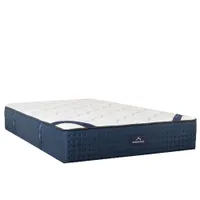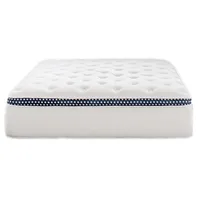This is why a sagging mattress causes lower back pain — and how to fix it

With the cumulative effect of night after night of sleep, it's almost inevitable that a mattress will eventually start sinking. But a sagging mattress is more than just an aesthetic concern — those dips and lumps might be responsible for your lower back pain.
Finding the best mattress for your sleep style can help you enjoy comfortable rest for longer, but once sagging sets in, even your favorite bed won't provide the support you need. Sagging can cause small twinges to morph into persistent pains, while your normally refreshing mornings might become creaky and uncomfortable.
Lower back pain can disrupt your day and your night, but there are ways to give your sagging a mattress a supportive refresh. While these quick fixes can't compare to buying a new bed, they're a short term solution for lower back pain caused by a sagging mattress.
Why a sagging mattress causes lower back pain
We need to be supported from head to toe when we sleep, as this allows the body to relax and get on with vital repair work overnight. But when a mattress starts sagging, it can no longer provide that support. Instead, your body will start to sink and twist out of alignment.
This sagging often occurs along the central third of the mattress, where most weight is applied to the bed. The result is a dip in the lumbar region, which is just where your body needs the most support. With your spine sinking into the bed, the muscles surrounding it have to stay active all night long. The result? Serious back ache in the morning.

Once your mattress has started sagging, it's a good indicator that you need to shop for a replacement. However, if that isn't an option (or you want a short term solution as you look for a new bed), there are ways to improve the support of your existing mattress to relieve lower back pain.
How to stop a sagging mattress from causing lower back pain
Lower back pain can keep you from falling asleep, wake you up in the night, and even ruin the next morning. If a sagging mattress is causing your aches, here are some things you can do about it:
Get instant access to breaking news, the hottest reviews, great deals and helpful tips.
Add a mattress topper for extra support
A mattress topper is an extra layer that sits on the surface of a bed and can help cover dips in a sagging mattress. This short term solution can smooth over the lumps and bumps, so instead of sinking into a sag, you're sleeping on the topper.
The best mattress toppers for sleepers with lower back pain are firm and measure three inches high (or more). This will better cover any sagging, providing a solid base for you to sleep against. Hybrid mattress toppers, which come with a layer of springs, can offer responsive support to the lower back. Alternatively, latex foam toppers tend to be firmer (and more durable) than memory foam toppers.
Viscosoft Active Cooling Copper Topper: was from $269.95 now $199.95 at Viscosoft
In our Viscosoft Active Cooling Mattress Topper review our testers found this top pleasantly firm, and at four inches tall it should mask minor sagging. There's 25% off in the Viscosoft sale, reducing a queen to $299.95 (was $399.95).
Place a pillow between the mattress and bed frame
An extra pillow beneath the mattress can add padding where your sagging bed needs it. Simply identify the dip before carefully placing the pillow between your bed frame and your mattress. This short term solution enhances the pressure relief while adding a touch more support.
Alternatively, place the pillow between your back and the mattress — but keep in mind it might shift around during the night. While a pillow can immediately relieve pressure, it only acts as a short term solution. This fix is best used when you're waiting for a new mattress (and struggling to sleep on the old one).
Add a bunkie board for even weight distribution
What goes under your mattress influences how the top of the bed feels, with platform bases often providing a firmer feel than a slatted bed frame. A sagging bed might be the result of the wrong base (especially if your mattress is only dipping on one side), and a bunkie board can be a quick fix.
A bunkie board is a flat board, typically made of plywood or particle, that sits between your bed frame and mattress. The solid surface distributes weight across the bed, preventing pressure from building up in any single area. It can also stop the mattress from sinking into the gaps between the slats, if this is the cause of your sagging bed.
Greaton 0.75 Inch Wooden Bunkie Board: from $47.44 at Amazon
A simple bunkie board that nevertheless gets the job done, the Greaton is available in both a wood and heavy duty wood finish, depending on your support needs. A queen will set you back $69.99 in wood, or upgrade to heavy duty wood for $93.
Invest in a new mattress
Ultimately, if your mattress is sagging it's a surefire sign that it needs replacing. A bed doesn't last forever — we recommend replacing your mattress roughly every seven to ten years — and once it has started sagging, most solutions are only a short term fix.
Mattress sales can help you save on a new, sag-free bed. But before making a purchase, consider what kind of bed you need. Is lower back pain a new problem caused by an old mattress? Or has sagging exacerbated an existing condition. If it's the former, you probably require a fresh mattress with a durable build. If it's the latter, you might want to consider a mattress that can help with your pain problems...
What type of mattress is best for lower back pain?
The best mattresses for back pain offer a balance of support and pressure relief. For this, we typically recommend a hybrid mattress. The sturdy coils provide a stable base for the entire body, while the upper layers of cushioned comfort materials ease pressure at the touch points. Memory foam mattresses can be good for back pain, but the dense foam must provide enough support.
We recommend a medium-firm mattress feel for back pain in general, but a firmer mattress can be best for lower back pain. Firmer mattresses prevent weight from being transferred to the hips, allowing for even pressure across the body.
Finally, look for a mattress with strong edge support. This ensures the sides of the bed are as strong as the center, so you can lie anywhere on the mattress without feeling your back start to sink.
3 mattresses for back pain to shop today
1. Saatva RX Mattress: was from $1,996 now $1,595 at Saatva
It's no surprise our testing panel praised the support of this luxury bed in our Saatva RX Mattress review, as it's been designed specifically for sleepers with chronic pain. A lifetime warranty offers good peace of mind and means you can expect many years of good sleep before any sagging kicks in. Right now there's $400 off all sizes, reducing a queen to $2,895 (was $3,295).
2. DreamCloud Hybrid Mattress: was from $1,013 now $419 at DreamCloud
The DreamCloud can't quite match the overall luxurious support of the RX, but this is a budget-friendly alternative that impressed our DreamCloud Mattress review panel. The current up to 50% off deal has been live at DreamCloud for most of this year, making this one of our favorite value for money beds. The queen is now $665 (was $1,483) and comes with a 365-night trial and a lifetime warranty.
3. The WinkBed mattress: was from $1,149 now $849 at WinkBed
The WInkBed is available in four different firmness levels — we tested the Luxury Firm in our WinkBed mattress review, but consider opting for Firmer if you want the best mattress for lower back pain. It's also available in Plus, which comes with an increased weight capacity and is ideal for heavy people with lower back pain. There's $300 off all sizes and feels in the evergreen sale, reducing a queen Firmer WinkBed to $1,499 (was $1,799).

Ruth is an experienced Senior Staff writer at Tom’s Guide, covering all things sleep and mattresses. She writes to help people sleep better, from how-tos to the latest deals to mattress reviews, and has interviewed an array of experts who share her passion. She is also our specialist on memory foam — she’s flown around the world to see memory foam being made — and leads our hotel mattress content. She has a deep interest in the link between sleep and health, and has tried enough mattresses, from Helix to Nectar to Simba, to know the right bed really can make a difference to your wellbeing. Before joining the team at Tom’s Guide, Ruth worked as a sleep and mattress writer for our sister website, TechRadar.





